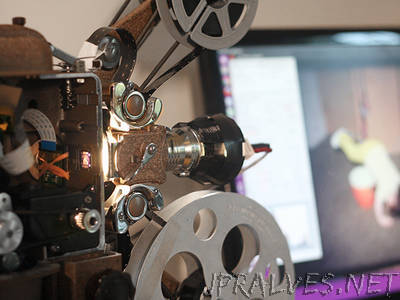
“My grandfather Leo was a self-taught electrical engineer and IEEE member who designed control systems for tire factories. He was also an avid photographer, and his eight children—and later, his grandchildren—were among his favorite subjects, right up to his death in 1974, when I was 5. Fast-forward to 2013: During a move, my uncle uncovered a trove of more than 130 reels of Leo’s 8-mm and 16-mm home movies, some dating back to 1939. While commercial conversion services exist, converting so many reels would have been pretty expensive, so my cousin and I set out to preserve them digitally ourselves, to better share them with Leo’s enormous extended family. First, a quick primer on film projection for digital natives. In a projector, a motor pulls film through a vertical “gate.” Each film frame is held still and flat in the gate while a lamp illuminates it from within the projector’s housing. Lenses on the other side of the gate focus the image so that it appears sharp on whatever surface the film is projected. Between the gate and the lamp, a rotating shutter wheel blocks the light while the next frame is sliding into position. (Without this shutter, the film would be one big blur.) For our initial movie conversion attempt, we tried to record digital video directly from a projector. We mounted a DSLR camera attached to a series of lenses focused on the gate. We started the projector and camera, and everything initially seemed to be going great. The camera recorded video with excellent detail and color. However, it also highlighted the dirt, cracks, and scratches on many of the reels. Even more problematic, the speed of our projector—as with most—couldn’t be precisely controlled. This meant that even under the best conditions, mismatches between the frame rates of the projector and the camera resulted in rolling dark areas, flickering, and other artifacts. These, along with the dirt and scratches, could not be easily remedied digitally. Going back to the drawing board, we learned that a frame-by-frame transfer—capturing a still image of each film frame and then converting the collection of images into a video—gives far superior results. The still images, in particular, are quite amenable to digital postprocessing. Such transfers are usually performed on specialized equipment for high fees. Fortunately, I remembered there was a spare Super 8 projector in my basement and an unused Raspberry Pi in my closet, and that a Pi camera was just US $30. Could we do a frame-by-frame transfer with these?”
